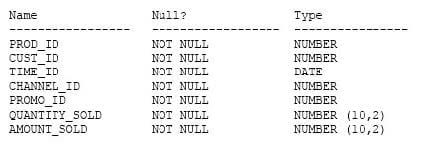1Z0-062 Online Practice Questions and Answers
What happens if a maintenance window closes before a job that collects optimizer statistics completes?
A. The job is terminated and the gathered statistics are not saved.
B. The job is terminated but the gathered statistics are not published.
C. The job continues to run until all statistics are gathered.
D. The job is terminated and statistics for the remaining objects are collected the next time the maintenance window opens.
Which two tasks can be performed on an external table? (Choose two.)
A. partitioning the table
B. creating an invisible index
C. updating the table by using an update statement
D. creating a public synonym
E. creating a view
Examine the structure of the sales table, which is stored in a locally managed tablespace with Automatic Segment Space Management (ASSM) enabled.

You want to perform online segment shrink to reclaim fragmented free space below the high water mark. What should you ensure before the start of the operation?
A. Row movement is enabled.
B. Referential integrity constraints for the table are disabled.
C. No queries are running on this table.
D. Extra disk space equivalent to the size of the segment is available in the tablespace.
E. No pending transaction exists on the table.
Examine the following command:
CREATE TABLE (prod_id number(4),
Prod_name varchar2 (20),
Category_id number(30),
Quantity_on_hand number (3) INVISIBLE);
Which three statements are true about using an invisible column in the PRODUCTS table? (Choose three.)
A. The %ROWTYPE attribute declarations in PL/SQL to access a row will not display the invisible column in the output.
B. The DESCRIBE commands in SQL *Plus will not display the invisible column in the output.
C. Referential integrity constraint cannot be set on the invisible column.
D. The invisible column cannot be made visible and can only be marked as unused.
E. A primary key constraint can be added on the invisible column.
Which three features work together, to allow a SQL statement to have different cursors for the same statement based on different selectivity ranges? (Choose three.)
A. Bind Variable Peeking
B. SQL Plan Baselines
C. Adaptive Cursor Sharing
D. Bind variable used in a SQL statement
E. Literals in a SQL statement
Your multitenant container database (CDB) contains a pluggable database, HR_PDB. The default permanent tablespace in HR_PDB is USERDATA. The container database (CDB) is open and you connect RMAN.
You want to issue the following RMAN command:
RMAN > BACKUP TABLESPACE hr_pdb:userdata;
Which task should you perform before issuing the command?
A. Place the root container in ARHCHIVELOG mode.
B. Take the user data tablespace offline.
C. Place the root container in the nomount stage.
D. Ensure that HR_PDB is open.
Examine the following command;
ALTER SYSTEM SET enable_ddl_logging = TRUE;
Which statement is true?
A. Only the data definition language (DDL) commands that resulted in errors are logged in the alert log file.
B. All DDL commands are logged in the alert log file.
C. All DDL commands are logged in a different log file that contains DDL statements and their execution dates.
D. Only DDL commands that resulted in the creation of new segments are logged.
E. All DDL commands are logged in XML format in the alert directory under the Automatic Diagnostic Repository (ADR) home.
A database instance is started by using an SPFILE. The database is configured in ARCHIVELOG mode and the control file autobackup is configured. Daily full database backups are performed by using RMAN.
You lost all control files due to media failure.
Given the steps to recover from the error in random order:
1.
Shut down the instance, if it is not already down.
2.
Restore the control file from autobackup to a new location.
3.
Start the database instance to NOMOUNT state.
4.
Recover the database to the point of failure of the control file.
5.
Open the database with the RESETLOGS option.
6.
Mount the database.
7.
Update the SPFILE with the new location of the control file by using the ALTER SYSTEM command.
Identify the correct sequence of the required steps.
A. 1, 3, 2, 6, 7, 4, 5
B. 1, 3, 7, 2, 6, 4, 5
C. 1, 3, 2, 4, 5
D. 1, 2, 6, 4, 5
E. 1, 6, 2, 4, 5
Which two statements describe the relationship between a scheduler window, a resource manager plan, and a job class? (Choose two.)
A. A scheduler window together with a job class, controls resource allocation for a job using that job class in that scheduler window.
B. A job class specifies a scheduler window that will be open when that job class becomes active.
C. A scheduler window specifies a resource manager plan that will be activated when that scheduler window becomes active.
D. A scheduler window specifies a job class that will be activated when that scheduler window becomes active.
E. A scheduler window can control resource allocation by itself.
What must you use to read data from a table in your database and write it to an external table?
A. Use SQL* LOADER conventional path load.
B. Use SQL* LOADER direct path load.
C. Use CREATE TABLE. . ORGANIZATION EXTERNAL command with ORACLE_LOADER access driver.
D. Use CREATE TABLE. . ORGANIZATION EXTERNAL command with ORACLE_DATAPUMP access driver.

